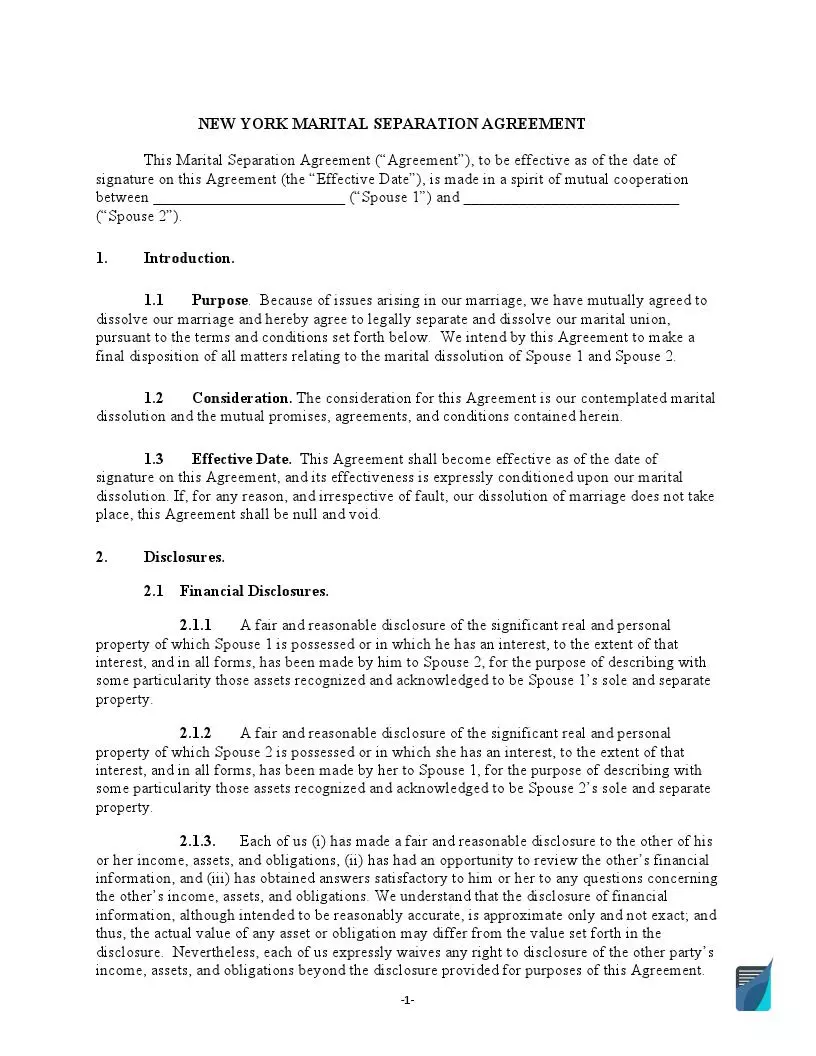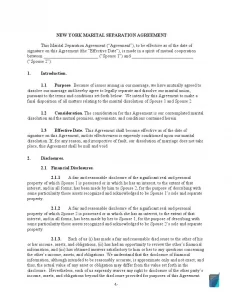New York Marital Settlement (Divorce) Agreement and Legal Separation
Nowadays, this is common for a married couple experiencing some troubles in their relationship to get apart. Whether they want to completely dissolve their marriage or just split up and divide their common property, an established legal process helps spouses do it effectively. In this article, we describe it step by step and here briefly introduce New York laws that regulate divorce and separation procedures.
When people need to deal with civil issues of any kind concerning two or more parties, they often have to sign a special agreement documenting their rights and duties towards each other. In the case of the marital relationships and their termination, partners are supposed to complete the Marital Settlement Agreement Form. This legally binding document is necessary for establishing specific conditions that spouses must handle after their divorce. The common terms included in this contract relating to property distribution, spousal maintenance, and child upbringing and support circumstances.

Build Your Document
Answer a few simple questions to make your document in minutes
Save and Print
Save progress and finish on any device, download and print anytime
Sign and Use
Your valid, lawyer-approved document is ready
Before bringing the contract to the court, let a professional look through the sections and review them. The lawyer’s involvement helps the parties to avoid conflicts and manage the requirements appropriately. Remember to notarize your document as well. We offer you our innovative form-building software that will construct the form correctly in a few seconds for your convenience. You should just enter the required information and sign the completed paper before sending it to the authorities.
New York Divorce and Separation Laws
This official paper may seem complicated to read and follow for a layperson. To make it easier for you to learn the existing rules, we outlined the document’s main points. Please keep reading to get acquainted with them.
Grounds for Divorce
Unlike no-fault states, the New York legislature accounts for specific situations when a divorce is considered reasonable. They are pretty varied, including such cases as:
- adultery
- confinement for three and more years
- violence or mistreatment
- separation for at least one year
- leaving a family without warning for at least one year
- irretrievable marriage breakdown
All of these factors are treated as legal grounds for divorce. It means that you will have to allege and prove one or more of them in court to start the process.
Property Division
To fairly and justly distribute the property and assets of ex-spouses acquired in their marriage, the court appeals to the equitable distribution law. It differs from the community property law used to divide the assets equally between spouses. Instead, the courts consider several factors that affect their final decision. Usually, they are concerned about both parties’ financial state, such as their employability and income, debts availability, and contributions made along with the marriage duration.
Child Custody and Visitation
Often, the divorcing couple has children that have not come of age yet. When this is so, both parents need to decide who will take care of their kids and participate in their upbringing. This process is called child custody, and it has two core aspects—physical and legal. The former refers to residential custody and implies that a parent will share one residence with the child and provide them with material and immediate care. The legal aspect means the parent will take the rights and responsibility for the child. They will be able to make decisions that might affect their future.
Whether one parent or both will take custody of their children depends on the court’s decision. The judge will take into account children’s personal preferences and the conditions of the family environment. Also, the judge may assign an attorney for the child to defend their best interest.
If the court concludes that a sole custodian is more reasonable, the other parent has a right to visit their child according to the established schedule.
Child Support and Alimony
To determine how much support will be provided to children, the court considers the parents’ income and the number of recipients born during the marriage. This calculation strategy follows the income shares model where the amount of support constitutes a certain percentage of combined parental income.
As for spousal support, also known as alimony or post-divorce maintenance, the court considers numerous factors for calculation. They include age and health characteristics, financial opportunities, specifics of child support, tax consequences, self-support ability, and others. The spouse with a larger level of financial independence will pay alimony to the other.
Popular Local Marital Settlement Agreement Forms
It’s better to spell out the terms of your divorce prior to the court hearing by writing a marital settlement agreement that deals with a range of points. Listed below are some of the most commonly searched templates for marital settlement by state.
Legal Separation
It is not always easy to break up the marital relationship with your spouse. A good alternative for such an action is to take a legal separation. The steps you should follow to comply with this process’s guidelines do not differ from those of divorce. Anyway, it may fit your needs better and help to reconsider your shared problems staying apart.
Being legally separated from your partner does not mean that you can register a new relationship with someone. Instead, both of you are still married. Legal separation allows you to live apart and without sharing your property or dissolving the marriage. Besides, it has some benefits that attract many couples today, such as a continuation of medical insurance, social security, and advantageous taxation.

Filing for Divorce in New York
If you chose to divorce your spouse, apply all the required materials to the supreme court of New York state. In doing so, remember that one of the applicants should be a New York resident for at least one year. In case your marriage was registered outside of the state, the requirements are more strict such that you or your spouse must be living in the state for at least two years before any legal procedures to be taken. This rule is obligatory to follow because otherwise, your filings will not be accepted.
Completing all the stages usually takes no more than three months. The exact duration of the period depends on the specifics of your case and your preparedness. Besides, remember that the court requirements vary from county to county. Contact your local authority for a detailed list of the necessary documents. We also recommend that you hire counsel to facilitate the process.
The document set is slightly different for spouses having children and those who do not have any. In this section, we will describe the general process of filing for both cases.
1. Submit the Forms
There are situations of contested and uncontested divorce, and both require filing a lot of forms. However, the latter takes less time, money, and effort as it implies that spouses came to an agreement upon all the terms and conditions and participated in the action voluntarily.
To initiate the process of uncontested divorce, the plaintiff needs to complete Summons Form and a Verified Complaint and send them to the court clerk. In some counties, the clerk may ask you to take an additional form where they assign the unique index number to the case.
Filing the forms mentioned previously will cost $210.
2. Contact the Respondent
Once the Summons and Complaint are filed, the plaintiff should inform the other party (the defendant) about the process initiation and deliver respective documents. They should serve the Summons, an Affidavit of Defendant, and other essential notices concerning divorce aspects such as maintenance and health care coverage to the defendant. Besides, if the spouses have children, the Child Support documents must also be filed.
The Affidavit signed by the defendant is considered to be their agreement and proof that the divorce is uncontested. In case of a failure to sign and return this document, the plaintiff should find a third party to serve it again and wait for a response for 40 days. If this situation happens one more time or the defendant comes with the notice of appearance, the process gains a contested divorce status.
3. Gather the Final Document Set
As soon as the parties are ready with their arrangements and signing, they should prepare and file the final set of applications, including Affidavits of Plaintiff and Defendant, Certificate of Dissolution of Marriage, Child Support, Maintenance forms, and the Note of Issue. Many other papers may accompany these. The fee charged at this stage is about $125.
4. Attend the Hearing
The divorce action normally ends with a hearing at the court where the judge reviews all the signed documents. This stage finalizes the period where they check whether everything is done under the laws and whether the terms of agreement concerning property division, child support, custody, and alimony are fair. If they make sure in fairness and justice of the case, they sign a particular form called Judgment of Divorce, and the marriage can be considered as officially dissolved.
5. Change Your Surname
You are also allowed to change your last name during the divorce process. You can do it by indicating the willingness to do so in one of the forms sent to the court. After their approval, you can use the dissolution decree as evidence for further procedures concerning your identification.

Other popular New York forms available for download on our site and that can be modified in our hassle-free document constructor.
Other Marital Settlement Agreement Forms by State